WS 94 pts! 1983 Taittinger Collection da Silva Brut Champagne with Glass Set
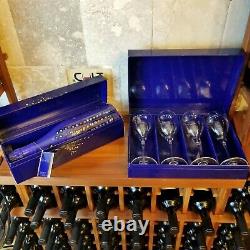
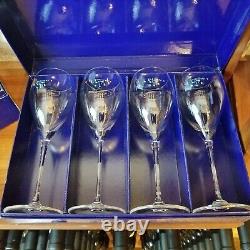
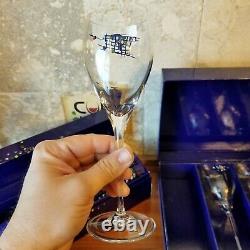
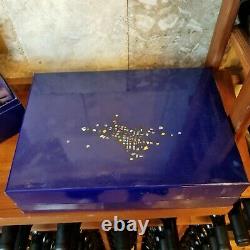
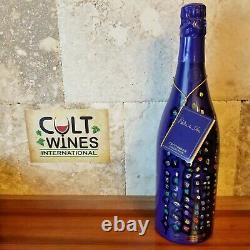
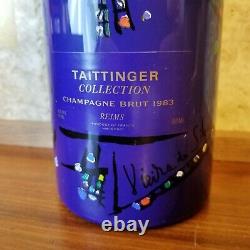

They don't get a whole lot better than this. Extremely flavorful and rich, packed with pear, hazelnut, toast and butter notes that linger on the finish. The powerful fruit flavor and firm acidity give it great strength on the palate. The Taittinger Collection Series was conceived in the late 1970s by Claude Taittinger.
Long a patron of the arts, with a passionate interest in the modern schools of painting and sculpture, he perceived a natural alliance between the creation of the artist and the art of the great winemaker. Thus, in 1983, Champagne Taittinger introduced the first of its revolutionary Collection Series, uniting art and Champagne in the design of a special bottle with a laser-sealed sheath that visually expresses the artist's concept of the magic of Champagne. Featuring the work of artists such as the French surrealist André Masson, American pop artist Robert Rauschenberg, and more recently the renowned Senegalese painter Amadou Sow, these exquisite bottles are commissioned well into the 21st century, and will perpetuate Champagne Taittinger's affiliation with the greatest artists of our time.Taittinger's Collection series was originally released in 1983. The goal of this collection is to unite Champagne and art by commissioning artists to design special edition bottles. These highly-collectible Champagne were produced from a blend of Chardonnay grapes from the best vineyards in the Côte de Blancs and Pinot Noir harvested from the best vineyards on the Montagne de Reims. Capsule: Tight with no corrosion. Perfect Comes with set of 4 champagne flutes in separate gift box as shown.
ALABAMA, ARKANSAS, KENTUCKY, MISSISSIPPI, AND UTAH. For these particular states, packages are only sent out on Mondays, Tuesdays and Wednesdays.
We apologize in advance for this inconvenience. We are not trying to penalize anyone but we cannot absorb these costs. To hold your order, please tell us in the "Comment" section of the order during checkout. We will hold you wine for free for up to 5 months. The wine may arrive with a tiny bit of wine that has seeped or leaked from the capsule.
Some buyers may find this upsetting, but typically such short-term heat exposure creates no damage to the wine itself. However, older vintages can be more fragile than newer ones. We have systems in place to prevent this. Cult Wines International also cannot guarantee the condition of the cork or quality of the wine in the bottles. We do not make the wine we sell. If you do not like the wine in the bottle, please take it up with the vineyard. On older vintages corks can shrink, and degrade.The cork may break or crumble when you remove it. This is normal for older wines. We do our best by storing the wine in optimum conditions and accurately describing the condition of the bottles, but obviously this is as far as we can go when it comes to quality assurance.
Cult Wines International cannot guarantee the condition of the cork or quality of the wine inside the bottles. Wines which we feel have provenance issues will be discounted greatly and will be detailed in the description. Wine is alive inside the bottle and changes over time. Cult Wines International cannot guarantee when the peak drinking window of a wine is. Older wines may be past their peak when you open them. Older vintage corks can shrink, and degrade. There is always a risk with older wines. It's as simple as that. You may open one up and have one of the greatest experiences of your life. You may open a similar bottle and find it's past its prime or oxidized. Some buyers do not know how to drink older wines, and in turn end up having a bad experience for no reason other than lack of knowledge. Keep in mind that the lower the fill level is of the wine inside the bottle, the greater chance the wine has oxidized. This is not a rule but rather a calculated risk. A wine at base neck or greater has basically no risk of oxidization. A wine right at halfway mid-shoulder has a 35-40% chance of being oxidized. Below that, the risk keeps increasing further.Keep this in mind when purchasing. Older wines have natural sediment in them that accumulates with age. These are tannins which precipitate out of the wine over time. The color of the wine will slowly fade from purple to brick red or even orange as the tannins accumulate and lump together to form the sediment. This sediment can be bitter when consumed but is harmless to health.
However, for the best drinking experience, it is a good idea to drink sediment-free wine. Allow all vintage wines to stand upright for several days and even sometimes a few weeks if the wine has very fine sediments (as in older Burgundy or Champagne). Once the wine is clear you can proceed to uncork and decant the wine. Keep in mind the final drinking place of the wine and keep the wine there until it settles.
If you bring an old wine with you to a friend's house or a restaurant with plans of drinking it that evening, you will disturb the sediments and make the wine impossible to properly decant. Do not use a standard corkscrew as older wines have corks which will easily break during extraction. We have pulled out corks whole from 1945 bottles with a Durand. We won't go into too much detail about decanting.
There are many great videos on YouTube which will show you how to properly decant vintage wine. However the idea of decanting is to gradually pour the wine into a different container while leaving (and without disturbing) the sediment in the original bottle.A small amount of wine will be left in the original bottle which is full of sediment and is typically discarded. The decanter can now be swirled, handed around and poured without risk of sediment issues.
Allow the wine to breathe. Older wines require less breathing time than younger wines, but still typically need about 25-30 minutes for best aromas and flavor. These wines have been cooped up in an enclosed container for many years and often can have a musty smell upon freshly opening. This will usually go away upon breathing.
Do not expect old wines to taste like better versions of young wines. Older wines often taste completely different to their younger counterparts.They lose their fruity qualities and their secondary complexities increase. More earthy notes and minerality is to be expected. Most often the bouquet of wine improves over time, imparting a smooth, rich flavor without the bitterness of a younger wine. However its intensity decreases and the wine feels lighter and thinner in the mouth. To many people these qualities are highly desirable, however there are many people who prefer younger wines also.
So simply don't assume you'll enjoy an old wine more than a younger one. Not all wines get better with age. Bold, higher-end red wines, complex whites and dessert wines are the ones to benefit most greatly from age. Varietals which typically get better with age are as follows. Riesling : A good Riesling can improve, growing rounder in flavor, virtually forever.
Cabernet Sauvignon: Bordeaux, California, and many other places produce Cabs with the bold richness needed to age well. However not all Cabs will develop delicious secondary and tertiary flavors. This is dependent on the structure, tannins, and richness of fruit needed to hold up to years of aging. Typically the higher-end Cabs are designed this way.
Budget Cabs aren't typically suitable for aging over 15-20 years. Chardonnay: This depends on acidity greatly. A rich, buttery Chardonnay won't have the structure necessary to age well and will fall apart within 5-7 years. Higher acidity Chardonnays with rich mineral tastes can very well improve with aging.
Namely higher-end French White Burgundies. Sauternes: Some of the longest lived non-fortified wines in the world.
The combination of sugar and alcohol give these wines an almost immortal lifespan and the complexities they can develop are endless. Fortified wine: Similar to Sauternes but even higher in alcohol and an extremely low chance of oxidization. Port, Madeira and the like age wonderfully because their high quantities of sugar and alcohol act to slow down the aging process, meaning that they can open well after even hundreds of years. Typically you can open the bottle, pour a glass and go back to the bottle months later to have another sip with the wine being completely unharmed. Pinot Noir : This is greatly variable depending on the level of Pinot. Budget Pinot tastes great and there's no need to hang onto it longer than 5-7 years.However many experts hold that a well-aged Pinot is the holy grail of the wine world. High end French Burgundies like Romanee Conti are considered a travesty if opened too young as their flavors can evolve unlike anything else in the wine world. Syrah: Most Syrahs age well, but only up to a limitabout 15 years.
Merlot: Merlot is a very forgiving wine when it comes to age. Many bottles can taste great young, however they can still benefit from some time in the cellar. Higher end Merlot like Petrus is well known for aging gracefully and beautifully. Zinfandel: Like Cabernet Sauvignon, many Zinfandels have the potential to age to greatness. Old Italian wines : Some varietals like Chiati do not benefit much from aging. Barolo is one of the world's greatest age-worthy wines. Brunello and Super-Tuscans are also excellent wines for aging. Italian wines from the 50s and 60s age well because they were made by farmers with primitive equipment. Their wines ended up very high in tannins, making them perfect aging candidates.The item "WS 94 pts! 1983 Taittinger Collection da Silva Brut Champagne with Glass Set" is in sale since Saturday, March 23, 2019. This item is in the category "Home & Garden\Food & Beverages\Alcohol & Alcohol Mixers\Wine". The seller is "cultwines" and is located in Venice, Florida.
This item can be shipped to United States.
- Rating: 90-95
- Allergens: Sulphur Dioxide and Sulphites
- Volume: 750mL
- Alcohol Content: 10,1-15%
- Vintage: 1983
- Region: Champagne, France
- Country/Region of Manufacture: France
- Grape Variety: Champagne Blend
- Base: Champagne blend
- Packaging: Bottle
- Growing Region: Champagne
- Rating System: Wine Spectator
- Brand: Taittinger
- Style: Sparkling
- Country of Origin: France
- Color: White
- Signed: No
- Sweetness: Brut
- Type: Blanc de Noirs

